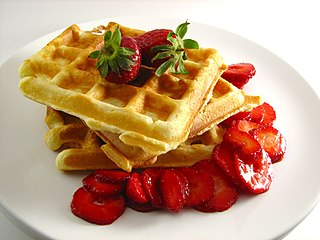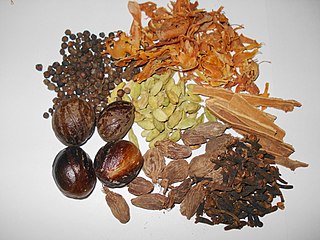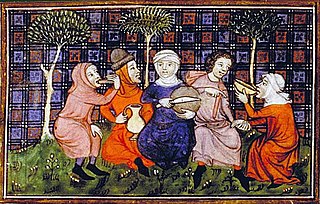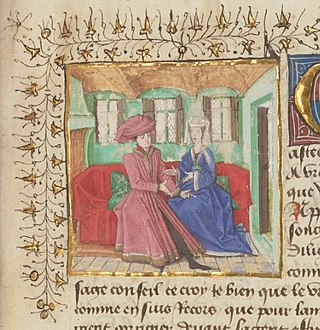Related Research Articles

Five-spice powder is a spice mixture of five or more spices used predominantly in almost all branches of Chinese cuisine. The five flavors of the spices refers to the five traditional Chinese elements. The addition of eight other spices creates thirteen-spice powder (十三香), which is used less commonly.

In the culinary arts, a spice is any seed, fruit, root, bark, or other plant substance in a form primarily used for flavoring or coloring food. Spices are distinguished from herbs, which are the leaves, flowers, or stems of plants used for flavoring or as a garnish. Spices are sometimes used in medicine, religious rituals, cosmetics, or perfume production. For example, vanilla is commonly used as an ingredient in fragrance manufacturing. Plant-based sweeteners such as sugar are not considered spices.

Catalan cuisine is the cuisine from Catalonia. It may also refer to the shared cuisine of Northern Catalonia and Andorra, the second of which has a similar cuisine to that of the neighbouring Alt Urgell and Cerdanya comarques and which is often referred to as "Catalan mountain cuisine". It is considered a part of western Mediterranean cuisine.

Mulled wine, also known as spiced wine, is an alcoholic drink usually made with red wine, along with various mulling spices and sometimes raisins, served hot or warm. It is a traditional drink during winter, especially around Christmas. It is usually served at Christmas markets in Europe, primarily in Germany, Czech Republic, Austria, Switzerland, Slovenia, Croatia, Romania, Nordics, Baltics and eastern France. There are non-alcoholic versions of it. Vodka-spiked mulled wine can be found in Polish Christmas markets, where mulled wine is commonly used as a mixer.

A waffle is a dish made from leavened batter or dough that is cooked between two plates that are patterned to give a characteristic size, shape, and surface impression. There are many variations based on the type of waffle iron and recipe used. Waffles are eaten throughout the world, particularly in Belgium, which has over a dozen regional varieties. Waffles may be made fresh or simply heated after having been commercially cooked and frozen.

Compote or compôte is a dessert originating from medieval Europe, made of whole or pieces of fruit in sugar syrup. Whole fruits are cooked in water with sugar and spices. The syrup may be seasoned with vanilla, lemon or orange peel, cinnamon sticks or powder, cloves, other spices, ground almonds, grated coconut, candied fruit or raisins. The compote is served either warm or cold.

The Forme of Cury is an extensive 14th-century collection of medieval English recipes. Although the original manuscript is lost, the text appears in nine manuscripts, the most famous in the form of a scroll with a headnote citing it as the work of "the chief Master Cooks of King Richard II". The name The Forme of Cury is generally used for the family of recipes rather than any single manuscript text. It is among the oldest extant English cookery books, and the earliest known to mention olive oil, gourds, and spices such as mace and cloves.

Spice mixes are blended spices or herbs. When a certain combination of herbs or spices is called for in a recipe, it is convenient to blend these ingredients beforehand. Blends such as chili powder, curry powder, herbes de Provence, garlic salt, and other seasoned salts are traditionally sold pre-made by grocers, and sometimes baking blends such as pumpkin pie spice are also available. These spice mixes are also easily made by the home cook for later use.

Biscotti, known also as cantucci, are Italian almond biscuits that originated in the Tuscan city of Prato. They are twice-baked, oblong-shaped, dry, crunchy, and may be dipped in a drink, traditionally Vin Santo.

Hippocras sometimes spelled hipocras or hypocras, is a drink made from wine mixed with sugar and spices, usually including cinnamon, and possibly heated. After steeping the spices in the sweetened wine for a day, the spices are strained out through a conical cloth filter bag called a manicum hippocraticum or Hippocratic sleeve, from which the name of the drink is derived.

Medieval cuisine includes foods, eating habits, and cooking methods of various European cultures during the Middle Ages, which lasted from the 5th to the 15th century. During this period, diets and cooking changed less than they did in the early modern period that followed, when those changes helped lay the foundations for modern European cuisines.

Le Ménagier de Paris is a French medieval guidebook from 1393 on a woman's proper behaviour in marriage and running a household. It includes sexual advice, recipes, and gardening tips. Written in the (fictional) voice of an elderly husband addressing his younger wife, the text offers a rare insight into late medieval ideas of gender, household, and marriage. Important for its language and for its combination of prose and poetry, the book's central theme is wifely obedience.

Picada is one of the characteristic sauces and culinary techniques essential to Catalan cuisine. The technique is typically found in Catalonia and Valencia and subsequently Catalan cuisine and Valencian cuisine. It is not an autonomous sauce like mayonnaise or romesco, but it is added as a seasoning during the cooking of a recipe.

Semolina pudding or semolina porridge is a porridge-type pudding made from semolina, which is cooked with milk, or a mixture of milk and water, or just water. It is often served with sugar, cocoa powder, cinnamon, raisins, fruit, or syrup. It is similar to grain based halva or halawa. A similar consistency to rice pudding can also be made by using more semolina and by baking, rather than boiling.

Bumbu is the Indonesian word for a blend of spices and for pastes and it commonly appears in the names of spice mixtures, sauces and seasoning pastes. The official Indonesian language dictionary describes bumbu as "various types of herbs and plants that have a pleasant aroma and flavour — such as ginger, turmeric, galangal, nutmeg and pepper — used to enhance the flavour of the food."

The Good Huswifes Jewell is an English cookery book by the cookery and housekeeping writer Thomas Dawson, first published in 1585. It includes recipes for medicines as well as food. To the spices found in Medieval English cooking, the book adds herbs, especially parsley and thyme. Sugar is used in many of the dishes, along with ingredients that are uncommon in modern cooking like violets and rosewater.

Kaeng hang le is a rich Northern Thai pork curry. Kaeng hang le is very popular in Northern Thailand, well-known as a specialty of the region. The curry differs from traditional northern Thai curries in several respects: it is typically eaten with long-grained rice, not sticky rice, and uses dried spices, which are commonly used in Burmese, but not northern Thai curries. The dish is commonly served as a festive dish in northern Thailand.
Powder-forte was a medieval spice mix similar to poudre douce, but often incorporating more pungent flavors like pepper. Spice mixes like powder-forte were a common ingredient in the recorded recipes of medieval cuisine, often used in combination with foods that are not heavily spiced in modern preparations. One example is a recipe for cherries, washed clean with wine and filtered through a cloth, then heated with "white grease" and rice flour in a pot until stiff. To this cherry mixture, the cook would add honey, vinegar, egg yolk and "strong powder" - in this case, a mix of cinnamon and cypress root. Along with poudre douce, poudre fine and poudre lombard it is one of four medieval spice mixtures found throughout an assortment of medieval cookery manuscripts.
Salsa de pago is a type of salsa found in medieval Catalan cuisine. The recipe for capons served with salsa de pago can be found in the 16th-century cookbook Libre de coch. This dish was served for Christmas dinner. According to the Libre de coch recipe it was made with ginger, cinnamon, cloves and saffron. The name salsa de pagó comes from peacock that the sauce is intended for, but it can be served with other types of poultry. It is similar to the recipe from the 14th-century Llibre de Sent Soví.

The Llibre del Coch, or Llibre de doctrina per a ben servir, de tallar y del art de coch cs de qualsevol manera, potatges y salses compost per lo diligent mestre Robert coch del Serenissimo senyor Don Ferrando Rey de Napols, is a Catalan recipe book written around 1490 by Master Robert de Nola. Its earliest preserved printed edition is from 1520, published in Catalan in Barcelona. It includes mainly recipes from the Catalan cuisine of the time, some of them inherited from the Llibre de Sent Soví, and some from neighboring countries, such as the Occitan cuisine and the Italian cuisine, including traditions from different areas dominated by the Crown of Aragon, which at that time was spread to the northeastern Mediterranean, Southern Italy, Corsica and Sicily. Despite not including Castilian recipes, was also very successful in Castile, was translated into Spanish in 1525 and republished in this language several times. It is considered of great value for acquiring a good knowledge about the gastronomy of the Renaissance.
References
- 1 2 The Gentleman's Magazine. Early English newspapers. F. Jefferies. 1905. p. 325. Retrieved April 23, 2018.
- ↑ Breverton, T. (2015). The Tudor Kitchen: What the Tudors Ate & Drank. Amberley Publishing. p. pt268. ISBN 978-1-4456-4875-0 . Retrieved April 23, 2018.
- ↑ The Goodman of Paris (Le Menagier de Paris): A Treatise on Moral and Domestic Economy by A Citizen of Paris, c.1393
- ↑ Schully, Terence (1997). The Vivendier:A Critical Edition with English Translation. p. 37. ISBN 9780907325819.
- ↑ "GLOSSARY OF MEDIEVAL & RENAISSANCE CULINARY TERMS". Thousand Eggs. Archived from the original on 2021-04-15. Retrieved 19 June 2021.
- ↑ Libre del Coch, Recipes 29-30